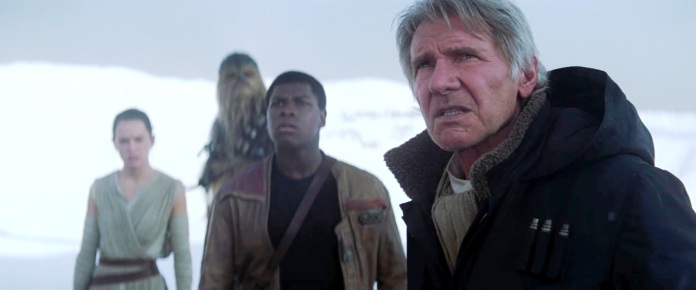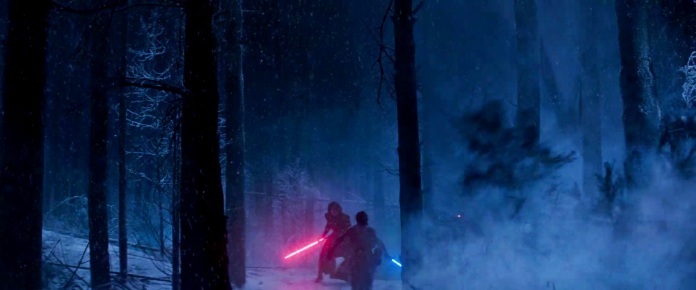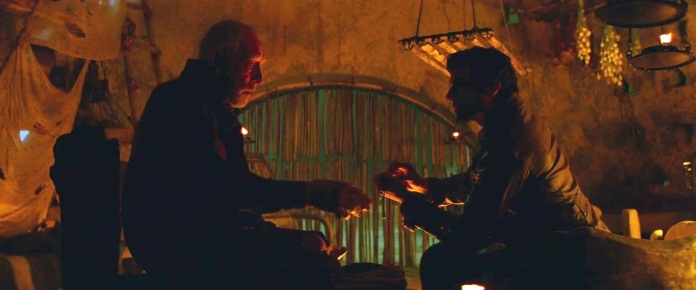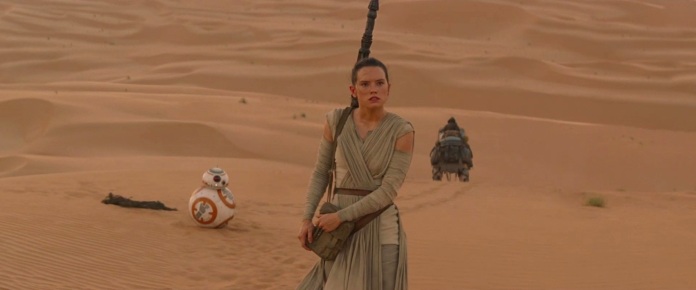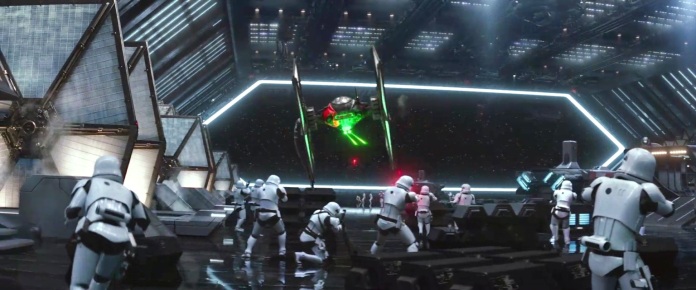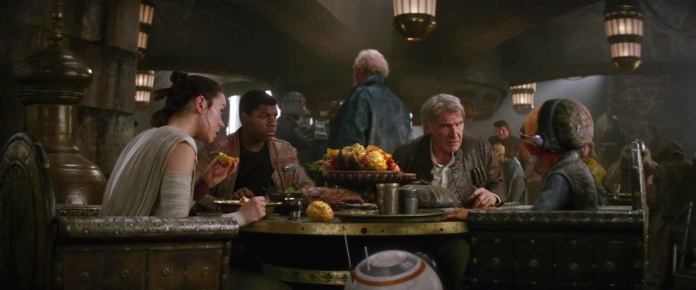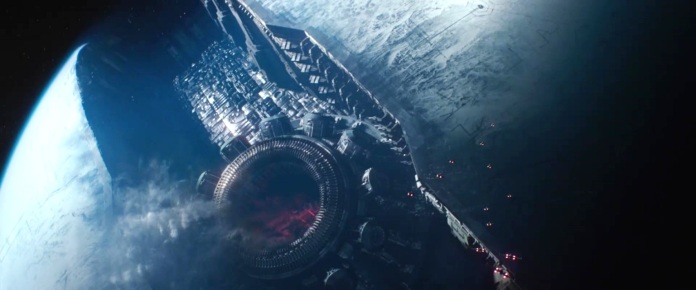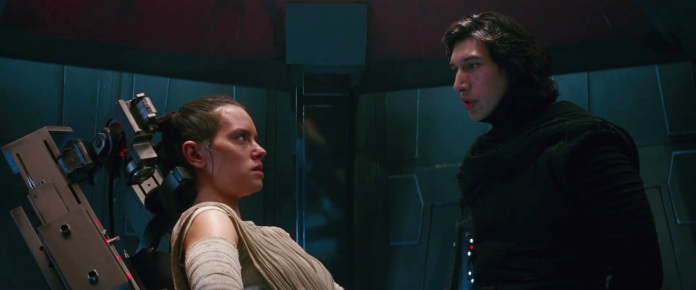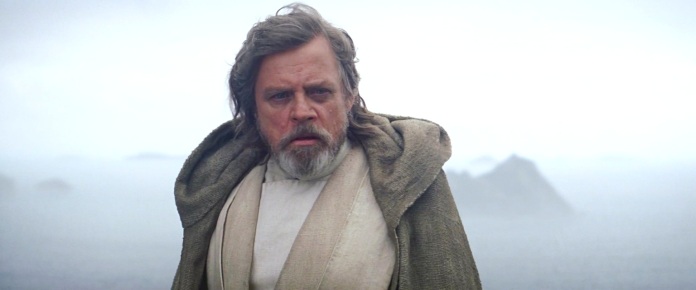.

.
Director/Screenwriter: Rian Johnson
By Roderick Heath
Although primed as the eagerly awaited follow-up to a hugely successful blockbuster and instant pop culture fixture, Star Wars: The Last Jedi had a daunting job of work ahead of it. If J.J. Abrams’ franchise-reviver The Force Awakens (2015) proved as tepid as often as tantalising in its effort to give fresh impetus to George Lucas’ canonical science-fantasy series, it did at least manage the task of introducing a new, appealing selection of heroes, and set them up as focal points for a grandiose cosmic drama, conveyed in lovingly produced and crafted cinema. But these exciting qualities weren’t particularly well-served by a new plotline that seemed determined to scrub the series blueprint down to its most simplistic outlines, and recycle familiar and comfortable looks and sounds from Lucas’ first trilogy without bringing any fresh ideas or conceptual zest to the table.
.

.
New helmsman Rian Johnson took on the challenge of dragging this new trilogy, laden with expectation and the inertia of franchise property protection, into richer, more novel, more genuinely epic territory. Johnson, a very talented filmmaker, turned heads with his 2005 gambit Brick, a film with the memorable conceit of having high schoolers play the protagonists of a noir film, a unique way of mediating the thrilling intensity and melancholy of teenage life. His second two films, The Brothers Bloom (2008) and Looper (2012), were entertaining but flawed attempts to expand his palette, radically different in tone and style but linked by efforts to blend his love of bygone ephemera and old movies with authentic efforts to tap the wellspring of emotions they stir in him, and his delight in telling tales of labyrinthine cunning. His best work post-debut was actually on several episodes of the TV series Breaking Bad, including “Fly,” a memorable instalment regarding its antiheroes’ efforts to catch a dogging fly in their underground meth lab, provoking all their festering anxieties to hatch out, as well as the pivotal episode “Ozymandias” where their lives actually fell to ruins. The Last Jedi actually takes on themes similar to those episodes, as it puts the Star Wars characters old and new in a pressure cooker and slowly but surely forces them to make choices regarding their lives, their beliefs, their loyalties, whilst their world topples.
.

.
In the wake of the briefly operational but catastrophically effective Starkiller’s destruction, the pulverised remnants of the restored Republic government and their Resistance warriors are forced to flee base after base, pursued by the First Order, the ruthless renascent offspring of the old Imperial forces led by the malformed but immensely powerful Supreme Leader Snoke (Andy Serkis). Famed Resistance pilot Poe Dameron (Oscar Isaac) leads a determined attack on a formidable First Order warship of a “Dreadnought” class, sporting giant energy weapons, to give time for Princess Leia (Carrie Fisher) and the rest of the Resistance leaders to flee. Poe ignores Leia’s commands to abort the mission, and instead calls in a flight of heavy bombers to pound the Dreadnought until the determined, self-annihilating efforts of one bomber pilot, Paige Tico (Veronica Ngo), succeeds in destroying the craft. Poe is put on the carpet and demoted for wasting too many good fighters and ships by Leia, and the Resistance fleet eventually finds itself crawling through deep space with the First Order, led by General Hux (Domhnall Gleeson), in close pursuit.
.

.
Desperate to come up with a way to get the First Order off their tail, Poe and pal Finn (John Boyega), who’s just awoken after spending months in care having terrible wounds repaired, team up with Paige’s low-ranked, hero-worshipping sister Rose (Kelly Marie Tran), who has a brainwave about the method the First Order is using to track them, and decides they need to sneak aboard their command ship and shut it down. Together, Finn and Rose take a fast, small ship to a nearby planet, Canto Bight, a playground for the super-rich, to find a codebreaker who might be able to penetrate First Order security recommended to them by Maz Kanata (Lupita Nyong’o). Thrown into prison for a parking violation before they can make contact, they encounter in their cell the scruffy, nefarious DJ (Benecio Del Toro). DJ casually breaks them all out of their cell to demonstrate his own talents at subverting authority, and soon they form a pact and flee the planet after raising some hell. Meanwhile, budding Jedi Rey (Daisy Ridley) is trying to convince Luke Skywalker (Mark Hamill) to leave his hermit existence in a remote Jedi temple on a lonely island and return to breathe new hope into the Resistance cause. But Luke is filled with regret and self-recrimination after his failure to revive the Jedi order and loss of young Ben Solo to Snoke’s influence and the mantle of his assumed evil guise as Kylo Ren (Adam Driver). Rey finds herself dogged by unexpected moments of psychic connection with Kylo, whose conflicts after killing his father Han seem to be boiling over.
.

.
If the most interesting subtext of The Force Awakens was its “tell me a story, grandpa” angle in contemplating chains of storytelling and their personal meaning, be it old war stories in the context of the on-screen drama and in meta terms the movies and other artworks you loved as a kid, The Last Jedi makes it clear that ardour for things wrapped in the comforting lustre of legend and period glamour must yield to a new and often dismaying reality. So Johnson commences with a mischievous assault on Abrams’ nostalgia, as he returns to the momentous final gesture of the first film, with Rey holding out to Luke his old lightsaber, that technocratic Excalibur: Luke takes the weapon, gives it a cursory look, and then tosses it over his shoulder in contempt. This is a great moment that signals Johnson’s theme, worked on several levels in the movie that follows, that his characters and their hopes can no longer be sustained by stale myths and old paradigms, and must jettison all that baggage to start again from scratch, to cleanse their temples and reinvent their institutions. It’s an intelligent and appropriate and, dare I say it, timely theme. It’s also, unmistakeably, a message aimed at the franchise itself. If Lucas’s prequels chased the ye-olde-timey ring of courtly sagas and his original trilogy evoked ‘40s screwball spark in their romantic scenes, Johnson’s dialogue and humour style here bring the series to a more definitely current, fashionable style. A joke early in the film sees Poe mock Hux by pretending to have him on hold on a speaker phone.
.

.
This is a funny moment that also signals, a touch annoyingly, that the Star Wars universe is being more exactingly annexed by a certain glib contemporaneity. Star Wars is no longer a legend of dreamtimes past; it’s a wing of modern pop culture founded by the likes of Joss Whedon. I suppose that’s inevitable to a degree, given that Lucas’s shift to set his tales entirely in a pseudo-historical zone with the prequels was the most fascinating and most ruthlessly rejected of his efforts. The opening sequence with the bombing raid is both thunderous spectacle but also rather senseless – the series has long been sustained by the unlikely notion of WW2-style aerial dogfights in space, but Johnson takes that here to a perfectly improbable extreme by reproducing that era’s style of bombing, with bombs dropped straight down with the use of gravity that doesn’t exist in space. On the other hand, the film’s central movement involves the agonisingly slow chase through deep space between the Resistance and First Order fleets, the latter maddeningly unable to catch the former at subspace speeds but only seeming to fend off the inevitable, in a plot motif bizarrely reminiscent of Master and Commander: The Far Side of the World (2003) in imposing clear physical limitations and cold equations upon the spacefaring (there are many yawning plot holes in the story, but I won’t carp on those). After Leia is almost killed in rocket attack on her ship, tensions mount in this agonising situation. As there doesn’t seem to be any way out save his friends’ risky plan, Poe feels provoked to rebel against acting fleet commander Vice Admiral Holdo (Laura Dern) when she seems to be intending a dangerous evacuation upon shuttle craft.
.

.
Star Wars has always been a bricoleur’s assemblage, defined by the ingenuity with which it mixed and matched classic film and pulp literary genres and a trove of mythological motifs. Abrams clearly worshipped at the altar of Lucas’ 1977 series foundation, but that seemed to be the limit of his referential frame. Johnson, on the other hand, is the sort of creative hand hip to Lucas’ method, at least to an extent, as Looper spliced incongruous motifs – time travel and psychic powers, gangster and hitman melodramas, old Hollywood and Anime – into an impressive if lumpy chimera. His preferred modes are classic noir and expressionist dramas rather than the swashbucklers, war movies, westerns, and sci-fi flicks Lucas took most inspiration from – screwball comedy is one significant overlap in their lexicon. This new influence is immediately apparent in the scenes on Canto Bight, where the grand casino inhabited by the smug-ugly has a veneer of ritzy glamour that proves instead to be a den of iniquity in a manner reminiscent of something like Josef von Sternberg’s The Shanghai Gesture (1941) or Howard Hawks’ The Big Sleep (1946). A pivotal incident in the past that caused Luke and Kylo’s break and the destruction of the fledgling Jedi renaissance is seen three times in revised flashbacks, a touch that echoes many a noir film’s sublimation of Orson Welles’ Citizen Kane (1941), and Kane and Welles are more clearly echoed in a sequence in which Rey attempts to confront her own nature as a creature of the Force and instead finds herself confronted by an endless hall of mirror selves, threatened like Welles’ antiheroes with mistaking her own ego for the state of the universe.
.

.
Johnson also emphasises the inequality and sleaziness pervading corners of this universe. Lucas’ vision for his future-past was always one of a society with a cynically profiteering sector – witness Han’s travails with Jabba the Hutt and Anakin’s lot as the slave of businessman Watto. Johnson tries to indict the forces at the centre of the Galactic community and their willingness to make money out of war. DJ highlights for Finn and Rose that the fortunes of Canto Bight’s denizens have largely been made selling arms to both the First Order and Resistance. The visit to Canto Bight finds Finn and Rose observing the brutality towards both animals engaged in racing, and the young human thralls used to prop up the lifestyle of the rich and famous, and the plucky Resistance warriors make common cause with both. The sequence in which Rose releases the racing animals is both fun but also a little too Harry Potter-esque for this imprimatur, whilst Johnson’s attempts to work up some of the sort of resurgence-of-the-repressed drama Lucas was so fond of – see THX-1138 (1971); Indiana Jones and the Temple of Doom (1984) – manifests in offering up a few waifs straight out of ‘30s Our Gang shorts making gosh-jeez faces. Johnson wants these kids to represent the notion that the Resistance instils hope and the basis for future resurgence, blended once again with the notion of loving this fantastical material as a viewer for its uplifting and dream-stirring cache, and the film’s very ending points directly to this process taking root in the minds of these young people.
.

.
This notion doesn’t land nearly as strongly as Johnson intends it, however. He wants us to feel the illicit rush of this rebellious spirit in his tale and also the daring in his lack of cool. Given that Lucas was flayed alive by the modern cool police by his choice to move entirely into the imaginative realm of kids on The Phantom Menace (1999), Johnson’s efforts feel only crudely calculated and tacked-on in skirting the same territory. Where the film is on surer ground is Rey and Luke’s tetchy, mutually frustrated relationship, which evokes but also revises Luke’s encounters with Yoda in The Empire Strikes Back (1980). Luke is a shambolic, self-exiled husk of his former self, detached from the Force and subsisting with hopes the Jedi way will die with him. Confronted by Rey’s raw natural power, he’s both impressed and terrified, as he’s already seen the same abilities in former pupil Kylo. Rey attempts to prod the Master back to action provoke scorn – “Did you think I was going out to take on the whole First Order with my laser sword?” Luke questions in derision. Hamill, whose performance is often taken as a weak link in the original trilogy, nonetheless matured into an excellent character actor in the course of his spotty career. He’s very good here, better indeed than Harrison Ford’s much-hailed equivalent turn was in The Force Awakens, as he invests his aged and haggard Luke with glimmers of his old, dreamy romanticism even as the damage his life failings have done to him gnaws incessantly at his core being. Of course, the question as to whether Luke will return to the fight isn’t really a question, only how and at what suitably dramatic juncture of the story.
.

.
One sharp failing of The Force Awakens was Abrams’ neglect of coming up with any genuinely inspired new technology or alien species. Johnson is more vigorous with the aliens, particularly on the temple island where Luke takes milk from giant, lolling walrus-like creatures to drink, and the Porgs, a race of small, furry, but relatively aware critters who object with memorably abject horror when Chewbacca (Joonas Suotamo) proposes to eat one of their fellows. But there’s still a notable failure to do much that’s interesting or properly, dramatically engaged with the new alien characters. Even Chewbacca, who has long stood vitally on the divide between sci-fi grotesque and beloved supporting character, is marginalised here, and his reunion with Luke is a paltry scene. Johnson does offer up one lovely dollop of fan service as Yoda (Frank Oz) appears to Luke when he’s determined to destroy the last of the Jedi’s founding texts. Rather than try to stop him, Yoda brings down a bolt of lightning to do the job for him, and patiently instructs him in the film’s theme, that faith has to be in the living avatars of the creed rather than relics of the past. Kylo, confronting Rey, makes the same point, encouraging to spurn her past and claim the future as her rightful possession.
.

.
This endlessly reiterated message feels as much like a poke in the ribs to cranky old fans like me as a dramatic imperative, and it might have had more impact if the film wasn’t trapped resolutely within the resolutely unimaginative framework Abrams and Lucasfilm-Disney provided. The new series has not just paid attention to all the criticisms aimed at the prequel trilogy but taken them so deeply to heart it’s caused creative rictus, in stripping things back to essentials: although there are little flourishes in the margins here, it’s still basically just an extended chase movie. The First Order, whose resemblance to a Khmer Rouge, Taliban, or Daesh-like force of fanatical opportunism has faded to leave them purely as Empire wannabes, represent the biggest failure in this regard. There’s still no inkling given of their aims, their credos, other than being the Bad Guys. Snoke is the Emperor without Ian McDiarmid’s wit and relish in instilling dimensions of Machiavellian smarts and rancid perversity in his character; Hux and Phasma (Gwendoline Christie) are still just sneering snobs. One quality that distinguished the Star Wars series under Lucas’ hand was the way it steadily evolved, accumulating lore, complexity, and emotional heft, even whilst maintaining an open, light touch for the broadest possible audience. Yes, the original film was a fleet, glib space western, but it laid groundwork quickly and deftly to suggest greater dimensions to everything we saw and felt, and then each of the following five films added something new. But in spite of Johnson’s calls to bring something new to the table and forget the past, he resolutely avoids the hard work of actually doing this.
.

.
Johnson indeed seems plainly impatient with much of the infrastructure he inherited from Abrams and Disney’s focus groups – very early in the film, he has Snoke mock and Kylo destroy the incredibly uninspired mask Kylo wore in The Force Awakens, and the path Johnson’s storyline cleaves through the set-up he was stuck with is similarly dismissive. One great task always facing Johnson was to try and come up with a twist as memorable as Darth Vader’s great reveal in The Empire Strikes Back. Johnson does provide a twist; several in fact, but not only do they not approach the momentousness of the model, they don’t really add up to much, in large part because they eventually cancel each-other out and leave the story precepts pretty much what they were at the outset. Much like Rey in her hall of mirrors, Johnson falls into the trap of merely deflating or offering slight tweaks on familiar moments. The flight to battle in rickety spaceships proves a tragicomic joke. The bad guy who becomes a good guy proves then to still be a bad guy – not once but twice. The pivotal scene here involves Kylo’s assassination of Snoke, a gleefully nasty if not total surprise, and one that concedes Snoke was just a ranting placeholder in the role of ultimate evil. Johnson’s staging of this sequence, and Rey and Kylo’s subsequent battle with Snoke’s bodyguards, is definitely the highpoint of the film, one that seems finally to engage with the sheer swashbuckling verve and operatic swerves of human nature of the series. And yet Johnson quickly undercuts its impact by having Kylo prove to be merely calculating rather than complex, and he ascends to the status of unchallenged bad guy, one who is apparently still enough of a sucker to not notice the difference when someone is projecting themselves on the astral plane.
.

.
The major subplot involving Poe’s clashes with and eventual mutiny against Holdo is another potentially intelligent story thread that doesn’t quite work, particularly as its raises a worthy and legitimate new theme about types of leadership. Poe, used to command and chafing against his reduction, becomes increasingly angry with the taciturn Holdo, and both fail to a certain extent in arguing for their positions. Johnson seems to be pitching here to launch a thousand think pieces on female leadership and male intransigence, which feels in a way a bit treacherous to the series’ comfort with women as leader figures (Leia, Mon Mothma, Padmé Amidala), which means ironically he’s had his talking point theme at the expense of this creative universe’s established, blithe indifference to contemporary gender politics (none of Padmé’s soldiers questioned her commands). Dern also feels rather miscast in the role, too, as it seems to demand someone with thorny hauteur and icy-eyed determination along the lines of Kristin Scott Thomas. That said, Holdo’s climactic act of vengeful self-sacrifice, ramming her space ship into Snoke’s at high speed, shattering the First Order fleet to smithereens, is a great piece of spectacle, made more effective by Johnson’s removal of all sound, simply observing the surge of pulverising energy and splintering metal. Here he really grips the quasi-Biblical scale of action and destruction matched to grandiose human will in the series forebears by the throat. And yet, again, Johnson doesn’t follow through with any clear depiction of the effect this has. Indeed, it has none on the First Order hunt and core villains.
.

.
Ridley and Boyega are still real finds for this series, and both of them display a developing touch in making their roles effective audience stand-ins who nonetheless have properly defined characters. But the way Finn and Poe are handled here makes them feel increasingly like fifth wheels. Finn is proved a dupe who flits about the margins and Poe’s struggles lead him into a position of new authority by the end that feels more accidental than earned. Finn’s final battle with Phasma aboard a disintegrating Star Destroyer is effectively melodramatic, but proves a little scanty. Johnson sets up a romantic triangle of sorts between Finn, Rose, and Rey – or rectangle if one counts Rey’s fleeting if finally extinguished attraction to Kylo. But it’s a long way from the smouldering love-hate of Han and Leia or the guilty, transgressive passion of Anakin and Padmé. Now we’ve got the adorkable pairing of Finn and Rose, which does lead into a gripping sequence in which Rose performs a staggeringly risky manoeuvre to save Finn from his own kamikaze gutsiness, but otherwise feels entirely too cute. Lucas’ characters were archetypes and naïfs, but they were also solid adults who had sex and dashed and dazzled. Everyone in this seems restricted, repressed, stymied. Part of what made The Empire Strikes Back as beloved as it is in spite of its nominally downbeat narrative of calamity and mutilation, was because it was the most authentically dreamlike of the original trilogy. The cavernous spaces and hovering beauty of Cloud City, dragon-riddled asteroids, haunted swamps, and spaceships roaring through twilight skies burned with ardour in authentic fantastical horizons. Nothing here even approaches, at least until the very end when Johnson evokes Lucas’ crucial images of setting suns and dissolution of the flesh, such a state of transcendental beauty.
.

.
Rey was and remains the best new character – I’ve heard many invocations that hold her as the sole real achievement and best reason for loyalty to the new series from fans both casual and hardcore – and The Last Jedi does drag her evolution to interesting new places. She’s the voice of a new and ardent breed who craves leadership and direction, appealing to a crusty old warhorse in the form of Luke in a manner that feels true to a real-world context today where the young have looked to older voices of undiluted radical vision. Rey is also beset by her mysterious bond with Kylo, with glimmers of erotic interest and tactile communion as they try to connect psychically (including Rey being distracted by the sight of Kylo sans shirt, a funny moment that also conveys a blessed note of the erotic, otherwise desperately missing from Disney Star Wars) coexisting with fierce antipathy. The film’s ultimate solution to the raised mystery of her parentage feels like another dodge, as her parents were just wastrels who sold her for coin, and her abilities are purely her own provenance. This is neat on a symbolic level, as it underlines Rey as the embodiment of the new and of re-founding rather than legacy, but it’s also rather, well, lame and anti-climactic. Luke reiterates a belief that the Jedi must end, but what exactly what might take the creed’s place, and what Rey in particularly could bring to it, again isn’t given any thought.
.

.
The Last Jedi does give Fisher a strong last go-round as Leia, who stands alone as a figure of stature and authority for the first time, running the Resistance cause with a sinking heart and guttering fire of determination. Leia gains some appropriately great moments, including one in which she utilises Jedi gifts surprisingly to save herself from a seemingly inevitable death. She also has a funny exchange with Holdo as they both admit their simultaneous irritation with Poe but also common love for his kind of bad boy. A running joke about Rey’s belief that the Force is the ability to make rocks float builds to a punch-line at the end involving her do just that. That’s about it. And this moment crystallised the way Star Wars has been vampirised by those pretending to reinvigorate it. There’s painfully little wonderment or fantastical beauty left in this universe. Johnson’s film looks good in a way, chasing a quality of desolate, dusky beauty, but too often it looks rather too often grey, dusty, and more than a little dolorous. Compared to the astounding opening sequence of Revenge of the Sith (2005) with it monumental, intricately staged, kaleidoscopically colourful space battle, Johnson’s paltry fleets slowly chugging through space are clunky and dully pseudo-realist. Of course, The Last Jedi is supposed to be set in a different, more run-down and wearied age, but that only covers a genuine paucity of real layering and ingenuity in effects and world-building so far.
.

.
The mantle of the Jedi no longer carries with it the scent of green bamboo shoots they inherited from their wu xia and samurai epic models nor the red petals of chivalric romance, and with them goes the very element that elevated Star Wars above its rivals in the modern special effects cinema arms race. And as dynamic as these cinematic inheritors try to be in filling its place, this absence of an elevated plane to the drama, a yearning for higher ideals and the resonance of myth, never mind Lucas’ attempts to encompass his ideas on history and society and the linkages of both to identity, depresses me deeply, as does the refusal to engage in the creative universe beyond the immediate survival drama beyond canards like some of the rich are bad. I might seem to be castigating The Last Jedi more harshly than it perhaps warrants: it’s still easily the best of the three entries (which also includes Gareth Edwards’ mediating one-off Rogue One, 2016) in the reinstituted series. It boasts a handful of powerful sequences, and although it features a finale that goes on a few scenes too long and tries playing the same hand over and over again, and builds to a properly momentous confrontation of Luke and Kylo, it’s only to, once again, reveal itself as a kind of a cheat, failing to deliver Luke to a consummation even close to what he (and the audience) deserves. The universe should shake to its foundations when Luke Skywalker dies. Instead, Johnson merely has him run out of puff. The new series has closed The Last Jedi tells me the series has plateaued in terms of what it can accomplish and how it’s going to do it, and that reasons why I’ve loved this material in the past are slowly but surely being neutered. Where the prequel trilogy has only doggedly and insistently earned my admiration for their achievement over the past decade or so, these new films lay all their cards on the table instantly.


